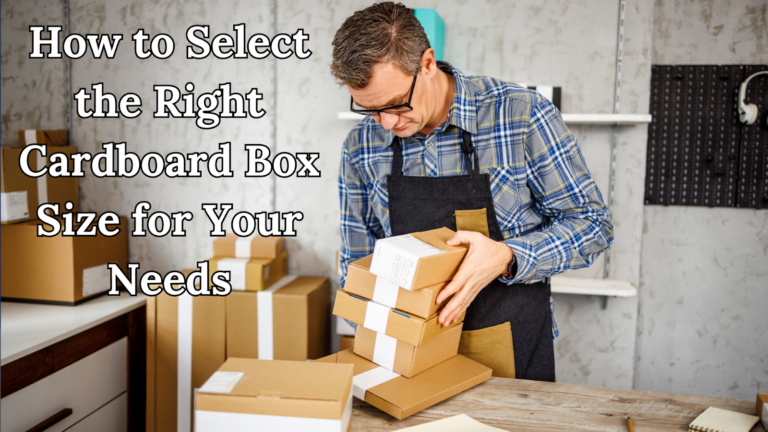Selecting the proper cardboard box size is not simply identifying a box in which these items will fit. Choosing between the two is an important decision that affects the costs of shipping, the protection of products, and the environment. Let’s dive into the essential factors you need to consider when selecting the ideal box size for your shipping needs.
Understanding Dimensional Weight
Dimensional weight pricing has slowly changed the shipping industry as it is known today. This pricing policy is an adaptation of the volumetric pricing where companies generate their shipping charges depending on the overall package dimensions instead of the exact weight of the consignment, even for small and large consignments of goods whereby the cost of shipping is cheaper for large goods with low density.
To be able to bypass those extra charges, learn about the dimensional weight formula employed by several carriers. Typically, you calculate the dimensional weight by multiplying the package’s length, width, and height, then dividing by a dimensional factor, usually 139 for domestic shipments.
Accuracy is the major aspect when it comes to determining the appropriate cardboard boxes to use. With the help of a measuring tape, you can find out the dimensions of your items in length, width, and height.
Measuring Your Items Accurately
Precise measurements are the foundation of selecting the right cardboard boxes. Use a tape measure to determine the length, width, and height of your items. For irregularly shaped objects, measure at the widest points. Don’t forget to account for any protective packaging materials you’ll use, such as bubble wrap or packing peanuts.
Remember, a snug fit is ideal. Boxes that are too large require more void fill, increasing material costs and waste. A study shows that oversized boxes can lead to a 50% increase in packaging material usage. On the flip side, boxes that are too small risk damaging your products during transit.
Considering Product Fragility
Although one should go for a very small box to save on the cost of shipping, do not forget that the goods may get damaged during transportation and the customer will be unsatisfied. The expenses in repackaging damaged items as well as managing the return of products also negate any advantages that may be accrued by using the small boxes.
Don’t leave the packaging strategies, to say the least without considering the lifetime value of the customers. A small amount of extra money that is added to the shipping price as a result of enhanced protection can be viewed by customers as a bonus and prompt them to buy a product again and leave positive feedback.
Optimizing for Multiple Items
When shipping multiple items, consider how they can be arranged to minimize space. Tetris-like packing can significantly reduce your package’s overall dimensions. However, ensure that heavier items are placed at the bottom of the box to maintain stability during transit.
For mixed shipments, group items of similar size and fragility together. This approach allows you to choose appropriate box sizes for each group, potentially using smaller boxes within a larger one to optimize space and protection.
Standardizing Box Sizes
For businesses with regular shipping needs, standardizing box sizes can streamline operations and reduce costs. Analyze your typical shipments and identify a set of box sizes that cover most of your needs. This approach simplifies inventory management and can lead to bulk purchasing discounts on packaging materials.
Companies implementing box size optimization strategies have seen a reduction in shipment volume, translating to substantial cost savings and improved logistics efficiency. Start by categorizing your products into size groups and selecting a range of box sizes that accommodate these groups with minimal wasted space.
Comparison Table: Standard vs. Custom Box Sizes
| Aspect | Standard Boxes | Custom Boxes |
| Initial Cost | Lower | Higher |
| Versatility | Limited | Tailored to specific needs |
| Minimum Order Quantity | Usually lower | Often higher |
| Storage Space Required | More | Less |
| Shipping Cost Efficiency | Variable | Potentially higher |
| Brand Presentation | Generic | Enhanced |
| Lead Time | Immediate availability | Longer production time |
Environmental Considerations
Selecting the right box size isn’t just about cost-effectiveness; it’s also an environmental responsibility. Oversized boxes contribute to unnecessary carbon emissions during transportation and excessive packaging waste. By choosing appropriately sized boxes, you’re reducing your carbon footprint and supporting sustainable shipping practices.
Consider using recycled cardboard boxes when possible. These boxes offer comparable strength to new cardboard while reducing environmental impact. Additionally, look for boxes certified by organizations like the Forest Stewardship Council (FSC) to ensure they come from responsibly managed forests.
Leveraging Technology
Modern shipping solutions often include box recommendation tools. These systems use algorithms to suggest the optimal box size based on your input dimensions and item characteristics. Simulate various shipping conditions during testing.
Some advanced systems even incorporate 3D scanning technology to accurately measure irregular items and suggest the most efficient box size. This technology can be particularly useful for businesses dealing with a wide variety of product shapes and sizes.
Testing and Refining
Once you’ve selected a box size, conduct thorough testing before committing to large quantities. Ship sample packages to various destinations and assess their condition upon arrival. This real-world testing can reveal unforeseen issues and allow you to refine your packaging strategy.
During testing, simulate various shipping conditions. Subject your packages to drops, vibrations, and temperature changes to ensure they provide adequate protection. This process may reveal the need for additional cushioning or a slightly larger box size for certain items.
Balancing Cost and Protection
While it’s tempting to choose the smallest possible box to minimize shipping costs, remember that inadequate protection can lead to damaged goods and unhappy customers. The cost of replacing damaged items and managing returns can quickly outweigh any savings from using smaller boxes.
Consider the lifetime value of your customers when making packaging decisions. A slightly higher shipping cost due to better protection can lead to increased customer satisfaction and loyalty, potentially resulting in more repeat business and positive reviews.
Seasonal Considerations
For businesses with seasonal fluctuations, consider how your packaging needs might change throughout the year. Holiday gift wrapping or summer heat protection might require adjustments to your standard box sizes.
During peak seasons, you may need to stock up on a wider variety of box sizes to accommodate gift sets or promotional bundles. Plan to ensure you have the right sizes on hand when demand increases.
International Shipping Considerations
When shipping internationally, be aware that dimensional weight calculations and restrictions may differ. Research the specific requirements for your destination countries to avoid customs delays or unexpected fees.
Some countries have strict regulations on packaging materials, particularly for wooden crates or certain types of plastic. Ensure your box choices comply with international standards to prevent shipments from being held at customs.
Customization Options
For businesses looking to enhance their brand image, custom-printed boxes can make a strong impression. However, these often come with minimum order quantities and longer lead times. Weigh the marketing benefits against the potential for excess inventory.
When considering custom boxes, think beyond just adding your logo. Incorporate helpful information like handling instructions or recycling guidelines directly on the box. This can improve the customer experience and showcase your brand’s commitment to sustainability.
Box Strength and Durability
The strength of your chosen box is crucial, especially for heavier items or long-distance shipping. Pay attention to the Edge Crush Test (ECT) rating, which indicates how much stacking pressure a box can withstand. For most shipments, a 32 ECT rating is sufficient, but heavier items may require 44 ECT or higher.
Consider the journey your package will take. If it’s likely to encounter extreme temperatures or humidity, opt for boxes with water-resistant coatings or treatments. This extra protection can prevent moisture damage and maintain the box’s structural integrity throughout its journey.
Void Fill Strategies
The choice of void fill material can impact your box size selection. Traditional materials like packing peanuts require more space than modern alternatives like air pillows or custom-cut foam inserts. By choosing efficient void-fill options, you can often use smaller boxes without compromising protection.
Experiment with different void-fill materials to find the best balance between protection and space efficiency. Some eco-friendly options, like corrugated paper or biodegradable packing peanuts, can also enhance your brand’s sustainability image.
provide extra strength and protection, ideal for valuable or delicate contents.
Optimizing Your Shipping Strategy with the Right Cardboard Box Size
Selecting the right cardboard box size is a crucial aspect of efficient and cost-effective shipping. By understanding dimensional weight pricing, accurately measuring your items, and considering factors like product fragility and environmental impact, you can optimize your packaging strategy. Remember, the goal is to find the sweet spot between protection and cost-efficiency. Take action today to review your current packaging practices.
Analyze your most common shipments and compare them against industry best practices. Consider implementing a standardized box size system or investing in packaging optimization software. By making informed decisions about your cardboard box sizes, you’ll not only save on shipping costs but also contribute to a more sustainable shipping ecosystem.
Regularly reassess your packaging choices as your product line evolves and shipping regulations change. Stay informed about innovations in packaging materials and technologies that could further optimize your box size selections. With careful consideration and continuous improvement, you can master the art of choosing the right cardboard box size for all your shipping needs.
Frequently Asked Questions
How much space should I leave in a cardboard box?
Aim for about 1-2 inches of space on each side for standard items. This allows room for protective materials without wasting space. For fragile items, increase this to 2-3 inches to accommodate more cushioning.
Can I use USPS Priority Mail boxes for non-Priority shipments?
No, USPS Priority Mail boxes are exclusively for Priority Mail services. Using them for other shipping methods is against postal regulations and can result in additional charges or returned packages.How do I determine if I need a double-walled box?
Consider using double-walled boxes for items over 20 pounds, fragile objects, or shipments that may encounter rough handling. They

